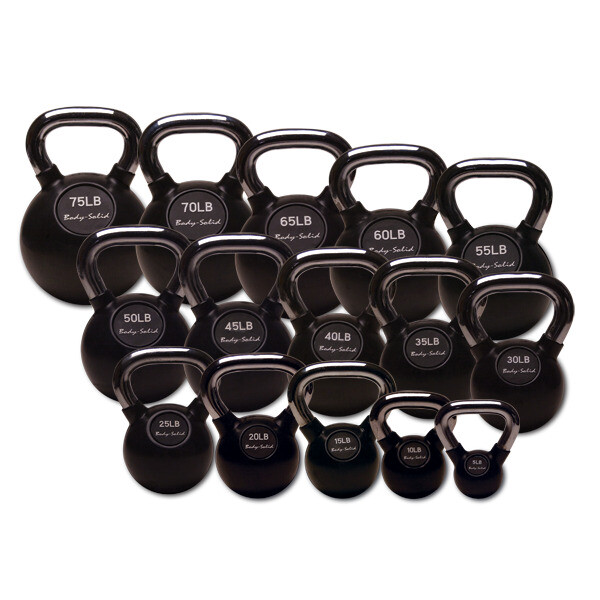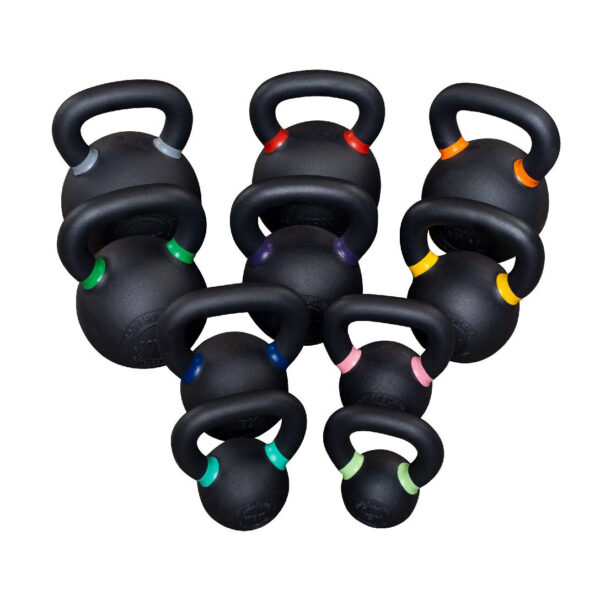Shop Kettlebells
Showing all 2 results
-

BODY-SOLID Premium Kettlebells
Price range: $13.00 through $715.00 Select options This product has multiple variants. The options may be chosen on the product page -

BODY-SOLID Training Kettlebells
Price range: $23.00 through $188.00 Select options This product has multiple variants. The options may be chosen on the product page
Why Choose Kettlebells?
Kettlebells combine strength, cardio, and mobility into one versatile tool. Their offset center of mass forces your body to stabilize, engaging core and small stabilizer muscles in every swing, press, and squat. Perfect for full-body conditioning, endurance circuits, and functional training, kettlebells deliver big results in a compact footprint.
Types of Kettlebells
Cast-Iron Kettlebells
Classic hex or round heads with solid handles—tough, affordable, and ideal for most home gyms. Sloped handles offer multiple grip positions for swings, cleans, and presses.
Competition Kettlebells
Uniform size and shape regardless of weight, with color-coded rings for quick identification. Made from steel for precision balance and durability—favorite among kettlebell sport athletes.
Soft-Grip & Soft-Shell Kettlebells
Cast-iron core with a vinyl or urethane coating and padded handles. Quieter, gentler on floors, and ideal for fitness studios or homes where noise is a concern.
Adjustable Kettlebells
Multiple weight plates or dial-in systems let you switch loads in seconds. Space-saving solution when you need 5–50 lb (or more) but can’t store a full rack.
Stainless Steel & Chrome-Plated Kettlebells
Premium finishes resist rust and wear. Smooth handles are ideal for high-rep circuits and commercial settings where hygiene and appearance matter.
Setting Up Your Kettlebell Station
Reserve at least 5×5 ft of clear floor space. Lay down a rubber mat to protect floors and soften noise. Install a wall rack or freestanding stand to keep kettlebells organized by weight. Ensure you have 7–8 ft of overhead clearance for overhead presses and swings.
Workout Tips & Sample Routines
Kettlebell Basics (20 min)
• Warm-up: 5 min of hip hinges and arm circles
• Goblet Squat: 3×12
• Two-Handed Swing: 3×15
• Single-Arm Press: 3×8 each side
• Deadlift to High Pull: 3×10
Metabolic Kettlebell Circuit (30 min)
• 8 rounds, 45 sec work/15 sec rest:
– Alternating Swing
– Goblet Reverse Lunge
– Clean & Press (alternating)
– Russian Twist
– Rest 1 min between rounds
Strength & Skill Builder (40 min)
• 5×5 Kettlebell Front Rack Squat
• 4×6 Single-Arm Rack-Position Press
• 3×8 Kettlebell Snatch (each side)
• 3×10 Renegade Row
Maintenance & Care
Wipe handles and heads after each workout to remove sweat and chalk. Inspect for cracks or coating chips—repair small vinyl tears with a rubber patch. Store kettlebells off the ground to prevent rust. For steel handles, apply a light coat of gun oil or 3-in-1 to protect against corrosion.
Frequently Asked Questions
What weight should I start with?
Beginners often begin with 12 kg (26 lb) for men and 8 kg (18 lb) for women. Choose a weight that lets you maintain good form through 10–12 reps.
Are competition kettlebells worth the extra cost?
If you frequently switch weights and value consistent size/feel (e.g., in classes or sport training), competition kettlebells are a smart investment.
How do I avoid grip fatigue?
Use chalk or beef up your grip with farmer’s walks. Rotating between soft-grip and bare-handle models also strengthens forearms over time.
Can I drop kettlebells like dumbbells?
Competition kettlebells are built to be dropped safely. Cast-iron kettlebells can develop cracks if dropped repeatedly—use caution and stick to controlled sets.